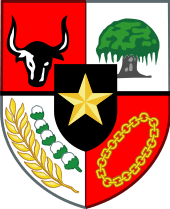Flag of Indonesia
The Flag of Indonesia is a simple bicolor with two equal horizontal bands, red (top) and white (bottom) with an overall ratio of 2:3.[1] It was introduced and hoisted in public during the Proclamation of Indonesian Independence on 17 August 1945 in at 56 Jalan Proklamasi (formerly Jalan Pegangsaan Timur) in Jakarta, and again when the Dutch formally transferred sovereignty on 27 December 1949. The design of the flag has remained unchanged since.
 | |
| Name | Sang Saka Merah-Putih Bendera Merah-Putih Merah-Putih |
|---|---|
| Use | National flag and ensign |
| Proportion | 2:3 |
| Adopted | 13th century (Majapahit Empire) 17 August 1945 (original) 17 August 1950 (official) |
| Design | A horizontal bicolour of red and white |
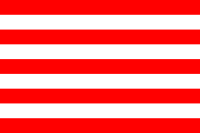 Variant flag of Indonesia | |
| Name | Ular-Ular Perang or Lencana Perang |
| Use | Naval jack |
| Proportion | 2:3 |
| Design | Nine horizontal stripes of alternating red and white |
The flag of Indonesia is graphically similar to the Flag of Monaco, with a slight difference in the shade of red, and ratio of its dimensions. The flag of Poland has similar dimensions but has the colours reversed: white on top and red on the bottom. In both, the red is of a slightly darker shade.
The Naval Jack of Indonesia is reserved for sole use by the Indonesian Navy. It flies from the mast of every active Indonesian war ship.[2] The design of the jack is described as nine alternating stripes of red and white. It is nicknamed Ular-ular Perang (War Pennant or literally "War Snakes"), probably due to the stripes' design. The naval jack dates to the age of Majapahit Empire. This empire, renowned for its great maritime strength, flew similar jacks on its vessels.[3]
History
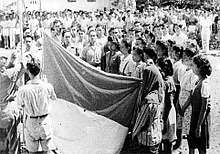
The flag's colours are derived from the banner of the 13th century Majapahit Empire.[4] However, it has been suggested that the red and white symbolism can trace its origin to the older common Austronesian mythology of the duality of Mother Earth (red) and Father Sky (white). This is why these colours appear in so many flags throughout Austronesia, from Tahiti to Madagascar.[5] The earliest records of the red and white panji or pataka (a long flag on a curved bamboo pole) can be found in the Pararaton chronicle; according to this source, the Jayakatwang troops from Gelang-Gelang hoisted the red and white banner during their invasion of Singhasari in the early 12th century. This suggests that even before the Majapahit era, the red and white colours were already revered and used as the kingdom's banner in the Kediri era (1042-c.1222).
Red and white textile colouring was available in ancient Indonesia. White is the natural colour of woven cotton fabrics, while red is one of the earliest natural dyes, acquired either from teak leaves,[6] the flowers of Averrhoa bilimbi, or the skin of mangosteen fruits.[7]
It was not only the Javanese kingdoms that used red and white. The battle flag of King Sisingamangaraja IX of Batak lands bore an image of white twin swords called piso gaja dompak against a red background.[8] During the Aceh War of 1873-1904, Aceh warriors used a battle flag with the image of a sword, star and crescent, sun, and some Quranic script in white on a red background.[9] The red and white flag of the Buginese Bone kingdom in South Sulawesi is called Woromporang.[10] The Balinese Badung (Puri Pamecutan) royal banner is red, white, and black,[11]. During the Java War (1825–1830) Prince Diponegoro also used a red and white banner.
In the early 20th century these colours were revived by students and then nationalists, as an expression of nationalism against the Dutch. The modern red and white flag which was first flown in Java in 1928, was prohibited under Dutch rule. Upon Indonesia's declaration of independence on 17 August 1945 it was adopted as the national flag, and has been in use ever since.[12] After Indonesia's independence was recognized, Monaco, which had a similar flag, filed a complaint which was largely ignored.[13]
Hotel Yamato incident
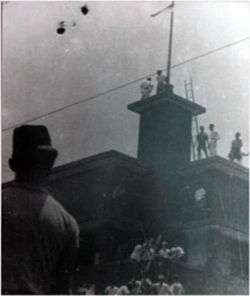
The flag featured in a well-known incident during the Indonesian War of Independence when during the lead-up to the Battle of Surabaya in late 1945, Indonesian youths removed a colonial Dutch flag flying over the Yamato Hotel, tore off the blue strip and re-hoisted it as an Indonesian flag. The Hotel was subsequently renamed Hotel Merdeka, meaning Independence Hotel.[14]
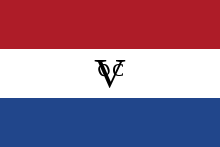 Flag of the Dutch East India Company used 20 March 1602 – 1 January 1800
Flag of the Dutch East India Company used 20 March 1602 – 1 January 1800 Flag of the Dutch East Indies used 1 January 1800 – 27 December 1949
Flag of the Dutch East Indies used 1 January 1800 – 27 December 1949.svg.png) Flag of Imperial Japan used 8 March 1942 – 17 August 1945 (3 years 5 months)
Flag of Imperial Japan used 8 March 1942 – 17 August 1945 (3 years 5 months) Flag of Indonesia used 17 August 1945 - present[15]
Flag of Indonesia used 17 August 1945 - present[15]
Name
The official name of the flag is Sang Saka Merah-Putih (meaning "lofty bicolour Red and White") according to Article 35 of the 1945 Constitution. The flag is commonly called Bendera Merah-Putih (Red-and-White Flag). Occasionally, it is also called Sang Dwiwarna (The bicolour). Sang Saka Merah-Putih (The Lofty Red-and-White) refers to the historical flag called Bendera Pusaka (heirloom flag) and its replica. The Bendera Pusaka is the flag that was flown in front of Sukarno's house after he proclaimed Indonesia's independence on 17 August 1945. The original Bendera Pusaka was sewn by Fatmawati, and was hoisted every year in front of the presidential palace during the independence day ceremony. It was hoisted for the last time on 17 August 1968. Since then it has been preserved and replaced by a replica since the original flag was deemed to be too fragile.[1]
Symbolism
Several opinions have been expressed on the meaning of the red and white in the Indonesian flag. One opinion is that the red stands for courage, while the white stands for purity. Another is that red represents the human body or physical life, while white represents the soul or spiritual life; together they stand for a complete human being.[12]
As Sukarno said:
Red is the symbol of courage, White is the symbol of purity. Our flag has been there for 600 years. [16]
The colours are the same as those used in the flag of the Majapahit.[17]
Colors
Digital scheme[18] | Red | White | Physical scheme | Pigment red | White |
|---|---|---|---|---|---|
| RGB | 255-0-0 | 255-255-255 | RGB | 237-28-36 | 255-255-255 |
| Hex | #FF0000 | #FFFFFF | Hex | #ED1C24 | #FFFFFF |
| CMYK | Inconvertible | 0, 0, 0, 0 | CMYK | 0, 100, 100, 0 | 0, 0, 0, 0 |
Usage
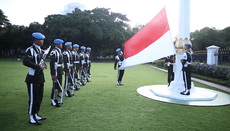
Regulation and flag protocol
The flag is described in Article 35, Chapter XV, of the Constitution of Indonesia; Government Regulation No. 24/2009; and Government Regulation No.40/1958.[19]
The national flag shall be Sang Merah-Putih (The Red-and-White)
The raising of the flag should be conducted in the time between sunrise until sunset, but in certain circumstances, it can be done at night. In daily use, the flag should be flown at every commemoration such as Indonesian Independence Day on 17 August every year, by the citizens who have a right to use it at house, building or office, schools, colleges, public and private transport and the representative office of Indonesia in overseas.[21]
It can be used as the cover of the coffin of President or former Presidents, Vice President or former Vice Presidents, Members of Cabinet, Speaker of People's Representative Council, and Head of Government, members of the Indonesian Armed Forces, and persons who are members of the Indonesian National Police who died in service, or an Indonesian citizen who made contributions to their nation as a badge of honor.[21]
The flag must be displayed everyday in places such as the Presidential Palace, government and private office buildings, border posts and outer islands in the territory of Indonesia, and the National Heroes Cemetery.[21]
The flag should be displayed everywhere on special days, which are:[19]
- 2 May: National Education Day.
- 20 May: National Awakening Day.
- 1 June: Day of the Birth of Pancasila.
- 17 August: Indonesia Independence Day.
- 28 October: Youth Pledge Day.
- 10 November: Heroes Day.
Half-mast
The flag should be displayed at half-mast as a sign of mourning on these days:[19]
- 26 December, in remembrance of victims of the 2004 Indian Ocean earthquake and tsunami.
- Three days after the death of President or former Presidents, Vice President or former Vice Presidents, Members of Cabinet, Speaker of People's Representative Council, and Head of Government.
- Other mourning days established by the government.
Usually, the Indonesian flag is also flown at half-mast on 30 September, in remembrance of the 30 September Movement, but after the New Order ended in 1998, this tradition stopped. However, in recent days, it still continues in some staff without official status by the government.[22]
Prohibited acts
Based on Act No.24/ 2009, all citizens are prohibited from:[19]
- destroying, tearing, trampling, burning, or performing other actions with the intention to tarnish, insult, or degrade the honour of the national flag;
- using the national flag for billboards or commercials;
- fly the national flag if it is torn, smudged, crumpled, or faded;
- printing on, embroidering or adding letters, numbers, images or other signs, or adding badges or any objects to the national flag;
- using the national flag to cover a ceiling or roof, or for wrapping or covering goods in a way that can degrade the honour of the national flag;
References
- "National Flag, Coat of Arms, Anthem". Embassy of Indonesia, Oslo, Norway. 1 May 2007. Archived from the original on 19 October 2007. Retrieved 22 June 2009.
- "(Indonesian) KRI Karang Unarang-985 Akhiri Pengabdian". Pikiran Rakyat. 22 October 2010. Archived from the original on 24 December 2010. Retrieved 21 December 2010.
- "(Indonesian) TNI : terima kasih ku terdalam padamu". Connie Rahakundini on Multiply.com. Archived from the original on 4 September 2010. Retrieved 21 December 2010.
- "Archived copy". Archived from the original on 8 May 2020. Retrieved 2 September 2011.CS1 maint: archived copy as title (link)
- "Blog nicht gefunden". Archive.is. 1 July 2012. Archived from the original on 1 July 2012. Retrieved 9 January 2018.
- "Natural Dye Extraction From Teak Leves (Tectona Grandis) Using Ultrasound Assisted Extraction Method for Dyeing on Cotton Fabric". ResearchGate. Retrieved 28 February 2019.
- "Extraction, Characterization and Application of Natural Dyes from the Fresh Mangosteen (Garcinia mangostana L.) Peel | Request PDF". ResearchGate. Retrieved 28 February 2019.
- "Kompas.Com". 17 November 2009. Archived from the original on 17 November 2009. Retrieved 9 January 2018.
- "Sejarah Bendera Merah Putih". Suryantara.wordpress.com. 30 October 2007. Retrieved 11 February 2017.
- "PANYINGKUL! Jurnalisme Orang Biasa". 25 August 2011. Archived from the original on 25 August 2011. Retrieved 9 January 2018.
- ian macdonald. "Flags in Bali". Fahnenversand.de. Retrieved 20 September 2012.
- "Indonesia". Flags of the World. 6 September 2006. Archived from the original on 2 April 2010. Retrieved 26 December 2007.
- "What are the rules for national flags?". BBC Magazine. 11 May 2005. Retrieved 13 November 2018.
- "Hotel Majapahit: Brief History" (PDF). Retrieved 4 April 2017.
- Cahoon, Ben. "Indonesia". Worldstatesmen.org. Retrieved 9 January 2018.
- Ramadhian Fadillah (17 August 2016). "Kenapa bendera Indonesia Merah-Putih? Ini jawaban Soekarno" [Why is Indonesia's Flad Red and White? Soekarno's Answers] (in Indonesian). Merdeka.com. Retrieved 20 June 2020.
- Smith, Whitney (9 February 2001). "Flag of Indonesia". britannica.com. Encyclopædia Britannica Online. Retrieved 19 August 2019.
- "Konstitusi, Lambang Negara, Bendera, Lagu Kebangsaan dan Bahasa". Indonesia.go.id. Government of Indonesia. Retrieved 8 August 2020.
- "UNDANG-UNDANG REPUBLIK INDONESIA : NOMOR 24 TAHUN 2009" (PDF). Badanbahasa.kemdikbud.go.id. Retrieved 23 February 2017.
- Indrayana, Denny (2008). Indonesian Constitutional Reform 1999-2002: An Evaluation of Constitution-Making in Transition. Jakarta: Kompas Book Publishing. p. 54. ISBN 978-979-709-394-5.
- "Mencermati UU No 24 Tahun 2009 tentang Bendera, Bahasa, dan Lambang Negara serta Lagu Kebangsaan". Angagaraq.org. 12 August 2009. Retrieved 11 February 2017.
- Archived 13 December 2016 at the Wayback Machine
External links
![]()
